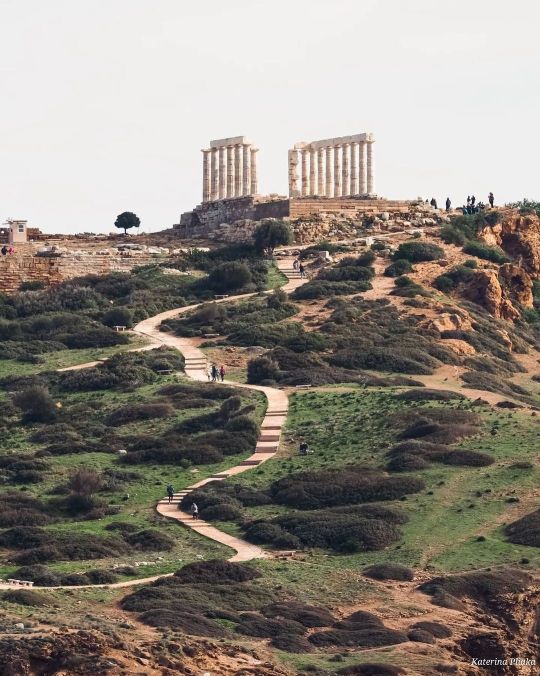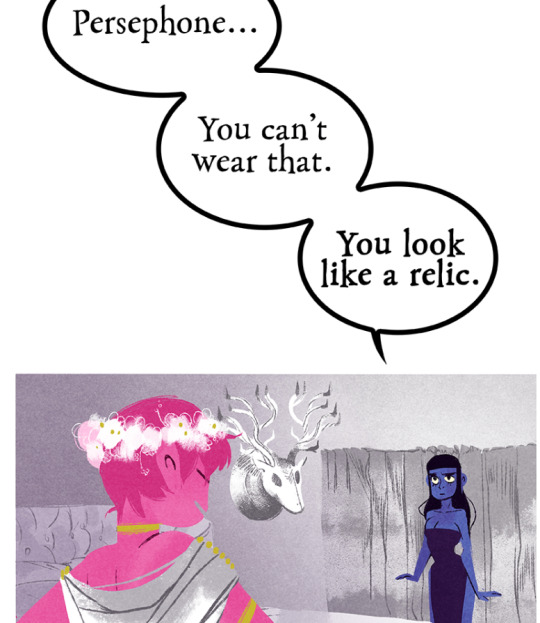#ancient greece culture
Explore tagged Tumblr posts
Text
Detail of a magnificent Attic red-figure lekythos from Taranto (Magna Graecia), dating to 470 BC.

(English / Español / Italiano)
It depicts the goddess Athena commanding Theseus to abandon Ariadne, who is asleep and seemingly dreaming of something pleasant, judging by her smile.
Perhaps she is traveling somewhere in her dream, as indicated by her soul depicted in the top left, appearing as though it wishes to go somewhere. On her head sits Hypnos, ensuring she does not wake before her time and her new fate—becoming the eternal companion of the god Dionysus, who pleaded with the other gods to make her immortal. At her feet lies a mysterious figure of a young man.
------------------------------------------------------------------------------
Detalle de un magnífico lekythos ático de figuras rojas procedente de Tarento (Magna Grecia), fechado en el 470 a.C. Representa a la diosa Atenea ordenando a Teseo que abandone a Ariadna, que duerme y parece soñar con algo agradable, a juzgar por su sonrisa.
Tal vez esté viajando a algún lugar en su sueño, como indica su alma representada en la parte superior izquierda, que parece querer ir a alguna parte. Sobre su cabeza se sienta Hypnos, que se asegura de que no despierte antes de tiempo y de su nuevo destino: convertirse en la eterna compañera del dios Dioniso, que suplicó a los demás dioses que la hicieran inmortal. A sus pies, la misteriosa figura de un joven.
-----------------------------------------------------------------------------
Particolare di una magnifica lekythos attica a figure rosse proveniente da Taranto (Magna Grecia), risalente al 470 a.C. Raffigura la dea Atena che ordina a Teseo di abbandonare Arianna, che sta dormendo e sembra sognare qualcosa di piacevole, a giudicare dal suo sorriso.
Forse sta viaggiando da qualche parte nel suo sogno, come indica la sua anima raffigurata in alto a sinistra, che sembra voler andare da qualche parte. Sulla sua testa siede Hypnos, che si assicura che non si svegli prima del tempo e del suo nuovo destino: diventare l'eterna compagna del dio Dioniso, che ha pregato gli altri dei di renderla immortale. Ai suoi piedi giace la misteriosa figura di un giovane uomo.
Source: The Archaeologist
#ancient greece culture#antica grecia#grecia antigua#attica#ática#magna graecia#magna grecia#lekithos#5th century bc#s.V a.C.
3 notes
·
View notes
Photo

Temple of Poseidon, Cape Sounion. Photo: catrin_pl (IG)
#greece#europe#travel#wanderlust#landscape#ancient greece#poseidon#ancient greek temple#temple of poseidon#cape sounion#attica#sterea hellas#central greece#mainland#greek culture
3K notes
·
View notes
Text



An Attic Pottery Pyxis Geometric Period, 8th Century B.C.
#An Attic Pottery Pyxis#Geometric Period#8th Century B.C.#pottery#attic pottery#attic greek#ancient pottery#ancient artifacts#archeology#archeolgst#history#history news#ancient history#ancient culture#ancient civilizations#ancient greece#greek history#greek art#ancient art#art history
840 notes
·
View notes
Text




Various Greek (and Roman) masks of Dionysus in terracotta, ivory, bronze and amber.
#ancient art#anient greece#ancient rome#ancient culture#ancient greek gods#ancient greek mythology#ancient history#dionysus
1K notes
·
View notes
Photo

The Temple of Aphaia, Aegina - Greece
#aegina#sanctuary of aphaia#hellas#ancient grrece#history#ancient ruins#ruins#sanctuary#temple#saronic islands#travel#greek islands#wanderlust#columns#architecture#greek temple#culture#attica#aphaia#greece
538 notes
·
View notes
Text

Venus by Alexandre Cabanel, 1875.
#aphrodite deity#lady aphrodite#hellenism#greek gods#greek mythology#hellenic polytheism#hellenic gods#hellenic paganism#hellenic deities#helpol#theoi#aphrodite#venus#greek culture#ancient greece#greek myth art#mythology art#art#classical art#artwork#artists on tumblr#painting#oil painting#oil on canvas#Alexandre Cabanel
329 notes
·
View notes
Text
Crazy to think that by now, Dionysus should have transitioned from a god of ecstasy to one of social refinement and polite gatherings if it weren't for ancient Greek religion losing its prevalence.
And I mean that Dionysus, as a god who promotes madness and disinhibitions, is what's left of a time when wine was our strongest alcoholic beverage, a time of maenads and symposiums. Nowadays, we have liquor (spirits), far better for getting drunk, and beer, as the always cheaper alternative, so in a "let's get drunk moment," wine isn't picked. That way, the beverage has been left to the sophisticated: culinary connoisseurs, elegant dinner parties, wine enthusiasts, elites, and intellectuals.
And if that's our perception of wine, shouldn't that also be the dominion of its god?
#dionysus#symposium#hellenic polytheism#ancient greek mythology#ancient greek religion#ancient greece#ancient greek gods#ancient gods#dionysus could have also become the god of spirits and wine and take a dual identity#but it's far more likely that a separated diety for spirits would have been created#overanalyzing#greek mythology#I know beer is older than wine#but more now than ever is cheaper and readily available for everyone anywhere#and it has this working man label attached to it that it didn't before#before beer vs wine was more Mesopotamia vs Greece#now that cultural alliance is lost#besides beer never had a higher alcohol % than wine
244 notes
·
View notes
Text

Sappho Playing the Lyre
Artist: Léopold Burthe (French, 1823–1860)
Date: 1849
Medium: Oil on canvas
Collection: Musée des Beaux-Arts de Carcassonne, Carcassonne, France
Sappho
Called the Tenth Muse by Plato, Sappho was a prolific poet of ancient Greece. She innovated the form of poetry through her first-person narration (instead of writing from the vantage point of the gods) and by refining the lyric meter. The details of Sappho’s life have been obscured by legend and mythology, and the best source of information is the Suidas, a Greek lexicon compiled in the 10th century.
Sappho was born on Lesbos to a noble family. She lived most of her life in the city of Mytilene, with the exception of her family’s brief exile in Sicily shortly after 600 B.C.E. She married a wealthy man in Mytilene, and they had a daughter names Cleis. Sappho also headed a thiasos, or an academy of unmarried women. As was the custom at the time, wealthy families sent their daughters to live at these schools where they were taught proper social graces, composition, singing, and poetry recitation. Much of Sappho’s poetry was composed in this community, and she used many of her students as subjects.
Perhaps Sappho’s most famous work is her “Ode to Aphrodite”:
Deathless Aphrodite of the spangled mind, child of Zeus, who twists lures, I beg you do not break with hard pains, O lady, my heart
but come here if ever before you caught my voice far off and listening left your father’s golden house and came,
yoking your car. And fine birds brought you, quick sparrows over the black earth whipping their wings down the sky through midair -
they arrive. But you, O blessed one, smiled in your deathless face and asked what (now again) I have suffered and why (now again) I am calling out
and what I want to happen most of all in my crazy heart. Whom should I persuade (now again) to lead you back into her love? Who, O Sappho, is wronging you?
For if she flees, soon she will pursue. If she refuses gifts, rather will she give them. If she does not love, soon she will love even unwilling.
Come to me now: loose me from hard care and all my heart longs to accomplish, accomplish. You be my ally.
(Carson, If Not, Winter, 2–5)
#painting#sappho#ancient greece#mountaintop#lyre#music#literature#poetry#lyric poetry#female figure#leopold burthe#french painter#oil on canvas#fine art#19th century painting#french culture#oil painting#artwork
178 notes
·
View notes
Text

Acrópolis, Atenas
1K notes
·
View notes
Text
even ignoring everything else wrong with lore olympus (which in itself feels impossible) there is just something really egregious and insulting at the way a "modern retelling" over an ancient greek myth just full-heartedly whitewashes the entire culture and mythos.
and it's not like rachel is the first to do it - greek myths and legends have been whitewashed for centuries, depictions of the gods have been categorically stripped of their ethnicity and origins long before rachel got a hold of them. it's the fact that rachel goes out of her way to insult the original myths whenever she can, that she emphasizes and pushes a western-centric mindset and viewpoint over and over and over and not only reinforces the whitewashing, but continues it down the line.
like, this is the first episode.

rachel goes out of her way to mock the original styles and wardrobes of the ancient greek world, and i get her attempt was to make persephone feel "out of place" with the more "modern" clothing that the other gods wear, but it really just does more to a) demonize demeter, who is almost always in traditional clothing, b) sexualize persephone.
go even broader with it, move away from the clothing itself, and rachel doesn't even bother to use any of the ancient traditions that are core to the myths. like for the love of god, she uses a christian wedding for persephone and hades!

greece is the birthplace of modern democracy and had a powerful judicial system, and rachel instead uses the modern / western iteration of court because ... why not

(completely unrelated but the inserts of everyone except eros and aphrodite come from the stupid zoom session zeus had back when he first charged persephone with treason, meaning we have proof yet again that rachel isn't drawing the characters into the scene, she's making pngs and sticking them into pre-arranged backgrounds downloaded from stock images)
and there are ten thousand more examples i could pull, because this is just the whole entire comic. you can look at a lot of modern adaptions and see where things have been modernized respectfully, and where they are done with disdain for the source material - no one is claiming percy jackson, for example, is perfect, but the author took a great deal of care in his research, and the love for the original myths and culture shine through. lore olympus has zero respect for the original stories, exemplified in how rachel demonizes demeter - the actual crux of the myth. it's bad writing and bad research and further attempts to whitewash a rich and storied culture that had people from so many walks of life, who existed in full spectrum of lgbt identity, who did not conform or even know of the world that exists today. you can modernize without erasing it, and rachel's refusal to do so is one of the many issues tacked to lore olympus.
#anti lo#anti lore olympus#i didn't grab the best screencaps bc there was literally so many to choose from lmao#but the wedding always bothered me SO much#ur in ancient greece!!! why are u doing this!!!#like i don't think it's wrong per SAY to have phones or tech in a story about ancient cultures#provided you explain how / why they're there#but of course there is ZERO world building in lore olympus
763 notes
·
View notes
Text

´´SÍGUEME´´
´´FOLLOW ME´´
(Español / English)
Estas son unas sandalias de una prostituta de la antigua Grecia, con la inscripción: ´´ΑΚΟΛΟΥΘΙ´´ "Sígueme", para que quedara marcada en la arena y posibles clientes se percataran de ella. Museo del Sexo, Praga-República Checa.
These are sandals of a prostitute from Ancient Greece, with the inscription: ΑΚΟΛΟΥΘΙ "Follow Me", so that it was marked in the sand and possible customers noticed it. Sex Museum, Prague-Czech Republic.
3 notes
·
View notes
Photo

An elaborate pebble mosaic from Aegae Palace in Vergina, Macedonia, Greece. Built by Philip II (c. 359-336 BC), father of Alexander the Great, it is one of the largest and most spectacular Hellenistic mosaics known.
photocredit: 17th Ephorate of Prehistoric and Classical Antiquities, Greece
#greece#europe#ancient greece#ancient greek art#mosaic#aegae palace#macedonia#ancient mosaic#archaeological sites#vergina#imathia#mainland#greek culture#greek history
3K notes
·
View notes
Text

HELLENISTIC GOLD RING WITH GALLEY GEMSTONE 1ST CENTURY B.C.-2ND CENTURY A.D.
#HELLENISTIC GOLD RING WITH GALLEY GEMSTONE#1ST CENTURY B.C.-2ND CENTURY A.D.#gold#jewelry#ancient jewelry#ancient artifacts#archeology#archeolgst#history#history news#ancient history#ancient culture#ancient civilizations#ancient greece#greek history#ancient art
234 notes
·
View notes
Text
achilles was a worse person in the iliad than in tsoa. some might say it’s inaccurate character adaptation, but i’d like to look at it as part of the tragedy.
it’s tragedy because now we have context. because we know who patroclus thinks achilles is. it’s tragic because patroclus knows the achilles who juggled figs and raced in lakes and adored patroclus’ mother’s lyre. the achilles patroclus knows would never commit such atrocities. the achilles patroclus knows wouldn’t torture somebody in such a way. that’s not his achilles. not anymore
it’s a tragedy because patroclus was the first to lose his life, but achilles was the first to die.
#ooo i got edgy 🤭🤭#tsoa patrochilles#tsoa#tsoa achilles#tsoa patroclus#patrochilles#patroclus#the song of achilles#achilles#achilles and patroclus#the iliad#homer's iliad#iliad achilles#iliad patroclus#trojan war#tagamemnon#the trojan war#greek tragedy#ancient greek#greek myth#homer#greek mythology#greek myths#ancient greece#greek culture#romantic tragedy
266 notes
·
View notes
Photo

The Temple of Aphaia (Aegina), Greece
The ancient temple of Aphaia is a masterpiece of Doric temple architecture and one of the most impressive archaeological sites in the country. It was erected between 500 and 490 BC on a very ancient cult place and on the site of a smaller predecessor, which had burnt to the ground. The actual newer temple contains undamaged elements of the older temple in its foundation, which kept it well-preserved.
#plaka#greece#europe#travel#original photography#photographers on tumblr#architecture#places#aegina#aphaia#columns#ancient ruins#history#culture#sea#summer#temple#ancient greece#greek gods#greek temple#photography
353 notes
·
View notes
Text

Dionysus as a child by Julie Duvidal de Montferrier, 1822.
#dionysus#dionysus deity#hellenism#greek gods#greek mythology#hellenic polytheism#bacchus#hellenic gods#hellenic paganism#hellenic deities#hellenic pagan#greek culture#greek art#ancient greece#art#classical art#artwork#artists on tumblr#painting#oil painting#greek myth art#mythology art#mythology#Dionysus with blond hair!!
214 notes
·
View notes